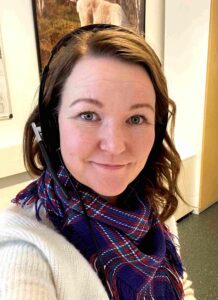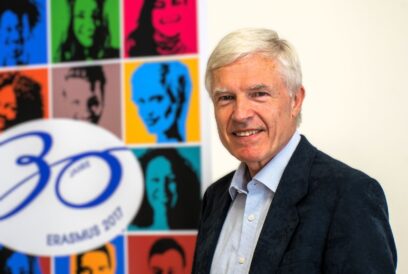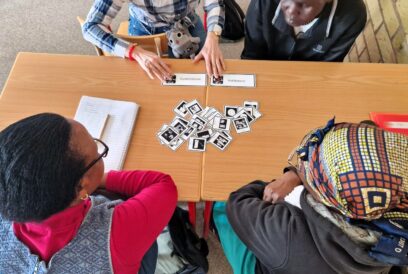Virtual distance education has increased interest and opportunities to study Sámi languages, says Tiisu-Maria Näkkäläjärvi, coordinator at the Sámi Education Institute in Finland.
“Interest in Sámi languages has increased considerably in the last five years, which can be attributed to growing public awareness regarding Sámi culture and our virtual distance education possibilities,” says Tiisu-Maria Näkkäläjärvi.

“We have persistently developed an Arctic pedagogy making it possible for distance education to develop and remain on the cutting edge,” says Tiisu-Maria Näkkäläjärvi. Photo: Tiisu-Maria Näkkäläjärvi.
Näkkäläjärvi is a coordinator at the Sámi Education Institute (SAKK) which is located above the Arctic Circle near the top of the world in Finland. SAKK, a vocational college with a central role in developing the needs of its people and the Arctic region, is the only indigenous people’s institute of vocational education in Finland. Since 2004, SAKK has offered virtual distance education courses for Sámi languages.
“SAKK has persistently developed an Arctic pedagogy through project management making it possible for distance education to develop and remain on the cutting edge,” says Näkkäläjärvi.
Cultural heritage
In Finland, there are three different Sámi languages spoken: Inari Sámi, Skolt Sámi, and Northern Sámi. Each has its own written language, orthography, and official status in the Sámi native region which comprises Enontekiö, Inari, Utsjoki, and the northern part of Sodankylä.
Sámi issues have been in the media in recent years as a controversial bill related to the self-governance of Finland’s indigenous Sámi people has remained unresolved through four successive coalition governments. There are approximately 10,500 Sámi people living in Finland.
In the European context, the Sámi are the only indigenous people in the European Union. An area inhabited by the Sámi comprises northern parts of Norway, Sweden and Finland and the Kola Peninsula in Russia.
The importance of diversity
One of the issues facing many language minorities around the world is the erroneous idea that preserving an indigenous language benefits only a small number of people.
Like diversity and inclusion in general, linguistic diversity benefits all of us.
To that end, linguist and endangered languages expert Anastasia Riehl, director of the Strathy Language Unit at Queen’s University in Canada, is often referenced for her apt quote: “Language is the cultural glue that binds communities together.”
Taking care of endangered languages is a central part of SAKK’s mission, says Näkkäläjärvi.
“As an educational institution, we feel that part of our role is to preserve languages. Our role in the revitalisation of the Sámi languages, especially for the Inari Sámi and Skolt Sámi, has been very significant,” says Näkkäläjärvi.
As an educational institution, we feel that part of our role is to preserve languages.
One of the main advantages of virtual distance education is that it provides opportunities for students that they might not have otherwise.
“The role of virtual distance education is key, as we can offer education both in the home region of the Sámi people where distances may be great and outside the home region of the Sámi people where a large part of the Sámi population lives,” says Näkkäläjärvi.
SAKK’s student body
With three campuses in the homeland of the Sámi, SAKK organises multidisciplinary contact-based and distance virtual education classes, workshops, and degree programmes for young adults and mature students. The core curriculum supports the livelihoods of the Sámi with emphasis on the development of the Sámi languages and Sámi cultures to promote nature-based occupations and employment.

The core curriculum supports the livelihoods of the Sámi with emphasis on the development of their languages and cultures to promote nature-based occupations and employment. Photo: SAKK.
SAKK is a state educational institution largely supported by government funding. In addition, SAKK generates revenue by organising training courses for different organisations and associations.
Since its inception, SAKK has trained thousands of students. Annually, there are about 150 students enrolled in vocational programmes. When language and handicraft courses are added, SAKK has close to 1,500 students per year.

There are about 150 students enrolled in vocational programmes every year. When language and handicraft courses are added, SAKK has close to 1,500 students per year. Photo: SAKK.
SAKK’s virtual distance education offers both basic education and language maintenance for native speakers. Student selection criteria is based on SAKK’s statutory task, while the training centre’s purpose is to increase the vocational skills of the Sámi population, organise training that meets the business needs of the Sámi home region, promote employment in the area, and preserve and develop the Sámi culture. To fulfill its mandate, the training centre organises vocational training and Sámi language and culture education, as well as produces and develops related learning material, online teaching, and other pedagogical support services.
Positive results
After every language training session and course, student feedback is collected.
“As training is organised remotely, for many people who live outside their home region studying languages with SAKK provides the only opportunity they may have to learn their own language, which is something we receive a lot of positive feedback about,” says Näkkäläjärvi.
Being able to study alongside work is another asset, as are the interactive and pedagogically versatile classes, the expert teachers, and technical support provided.
“Our teachers are very committed to their work, which is also evidenced by the minimal dropout rate,” says Näkkäläjärvi.

SAKK has three campuses in the homeland of the Sámi. It organises multidisciplinary contact-based and distance virtual education classes, workshops, and degree programs for young adults and mature students. Photo: SAKK.
AI future?
Technical challenges have provided a good opportunity to further test and develop project work and models that work in piloting, says Näkkäläjärvi.
When it comes to artificial intelligence (AI), the future remains to be seen.
“AI is both an opportunity and a threat,” says Näkkäläjärvi. “The possibilities it brings are still a big question mark for us in terms of teaching the Sámi languages. But we are exploring the options. One can’t be too scared, but should boldly go forward using strong expertise. Our dream is to offer Sámi-language studies – for those whose mother tongue it is – at all vocational education institutes throughout Finland. In addition, we want to continue our high-quality work to advance Sámi language studies and offer courses that are relevant for the working life needs of Sámi speakers.”
Our dream is to offer Sámi-language studies – for those whose mother tongue it is – at all vocational education institutes throughout Finland.
A pilot distance learning project for Sámi languages is also currently underway, where elementary, middle school, and high school students can study Sámi languages through virtual distance education, says Näkkäläjärvi.
“The quality of SAKK’s education is also an achievement that guarantees students the possibility of further studies and partial credit for university-level studies. Curriculum work that includes interactive teaching engages students in their studies and brings results to language learning,” she says.
Tiisu-Maria Näkkäläjärvi
- is a virtual education programme coordinator who designs the distance Sámi language courses at the Sámi Education Institute (SAKK)
- maps out different organisation’s needs of Sámi languages studies
- finds funding and helps to promote Sámi language education
SAKK in a nutshell
- the Sámi Education Institute (SAKK), founded in 1978
- the only indigenous people’s institute of post-secondary education in Finland
- it has three campuses in the homeland of the Sámi and organises multidisciplinary contact-based and distance virtual education classes, workshops, and degree programs for young adults and mature students
- encourages partnerships with national and international networks in preserving and developing the education of indigenous cultures and livelihood in the circumpolar north
- teaches all educational programmes, courses, and workshops in Finnish and/or Sámi, though occasionally, other languages of instruction may be used













